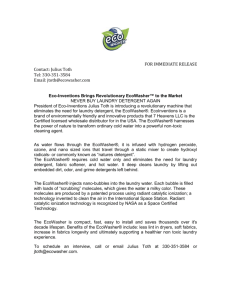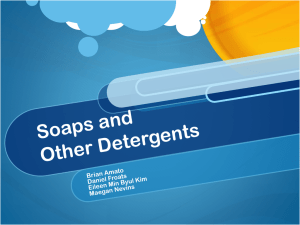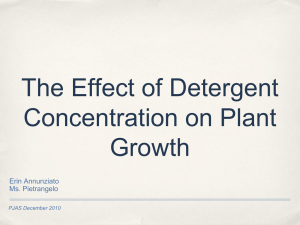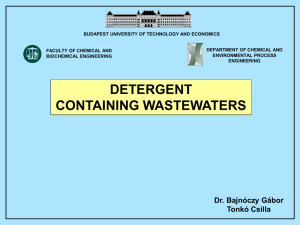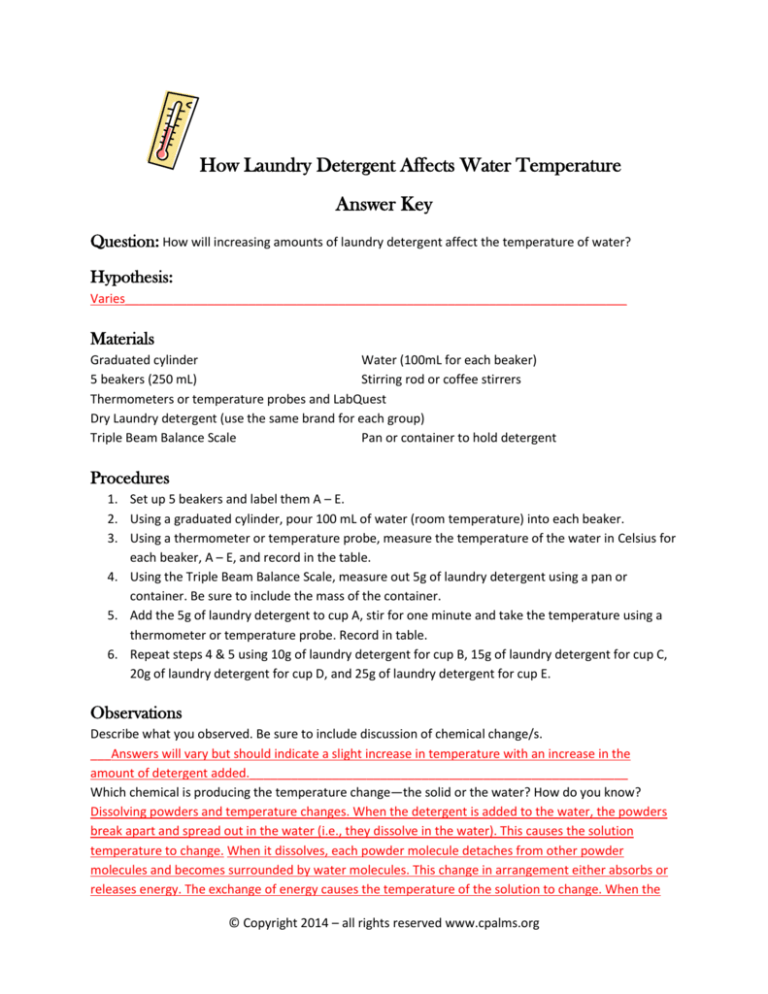
How Laundry Detergent Affects Water Temperature
Answer Key
Question: How will increasing amounts of laundry detergent affect the temperature of water?
Hypothesis:
Varies_________________________________________________________________________
Materials
Graduated cylinder
Water (100mL for each beaker)
5 beakers (250 mL)
Stirring rod or coffee stirrers
Thermometers or temperature probes and LabQuest
Dry Laundry detergent (use the same brand for each group)
Triple Beam Balance Scale
Pan or container to hold detergent
Procedures
1. Set up 5 beakers and label them A – E.
2. Using a graduated cylinder, pour 100 mL of water (room temperature) into each beaker.
3. Using a thermometer or temperature probe, measure the temperature of the water in Celsius for
each beaker, A – E, and record in the table.
4. Using the Triple Beam Balance Scale, measure out 5g of laundry detergent using a pan or
container. Be sure to include the mass of the container.
5. Add the 5g of laundry detergent to cup A, stir for one minute and take the temperature using a
thermometer or temperature probe. Record in table.
6. Repeat steps 4 & 5 using 10g of laundry detergent for cup B, 15g of laundry detergent for cup C,
20g of laundry detergent for cup D, and 25g of laundry detergent for cup E.
Observations
Describe what you observed. Be sure to include discussion of chemical change/s.
___Answers will vary but should indicate a slight increase in temperature with an increase in the
amount of detergent added._______________________________________________________
Which chemical is producing the temperature change—the solid or the water? How do you know?
Dissolving powders and temperature changes. When the detergent is added to the water, the powders
break apart and spread out in the water (i.e., they dissolve in the water). This causes the solution
temperature to change. When it dissolves, each powder molecule detaches from other powder
molecules and becomes surrounded by water molecules. This change in arrangement either absorbs or
releases energy. The exchange of energy causes the temperature of the solution to change. When the
© Copyright 2014 – all rights reserved www.cpalms.org
powder molecules release energy in the solution, it heats up. You can use the temperature of the water
to see the change of energy transferred.___________________________________________________
Which chemical changes more when they are combined?
__If the water were to evaporate and all that was left was the laundry detergent, the laundry detergent
would fail to maintain its properties because some of the chemical components in the detergent would
attach to the water molecules making the water contaiminated. Special note - Teachers can refer to this
article, “A Study on Chemical Contamination of Water Due to Household Laundry Detergents” by Geetu
Goel and Surinderjit Kaur in the Journal of Human Ecology (2012), Volume 38, Number 1, pages 65-69.
_http://bit.ly/1mWaQTN ______________________________________________________________
DATA TABLE
Beaker
Amount of
detergent
added
Group Water
Temperature
(°C)
Group Water
Temperature
(°C)
A
5g
24.3°C*
24.5°C*
B
10g
24.2°C*
25.0°C*
C
15g
23.8°C*
25.3°C
D
20g
23.8°C*
25.9°C
E
25g
23.8°C*
26.8°C
(*These can vary as well, what is shown is one sample)
Class Average
Water and
Laundry
Detergent
Temperature
(°C)
varies
Varies
Varies
Varies
varies
Class Average
Water and
Laundry Detergent
Temperature (°C)
varies
Varies
Varies
Varies
varies
Checklist for Graphs
□Export the chart above into Excel
□Create a scatter plot graph.
□Right click one of the points on the graph, and choose “Add Trendline”.
□Make sure you click “Display Equation on Chart”, and “Display R squared value on Chart”.
□ Choose Linear to check if the graph has linear or nonlinear associations.
□Export the data into GeoGebra and check for outliers and clusters.
Excel
Sample:
Beaker
A
Amt of Det
5g
Water
24.3°C*
Water &
Det
24.5°C*
Water T
Water & Det
T
24.3
24.5
B
10g
24.2°C*
25.0°C*
24.2
25
C
15g
23.8°C*
25.3°C
23.8
25.3
D
20g
23.8°C*
25.9°C
23.8
25.9
E
25g
23.8°C*
26.8°C
23.8
26.8
Amt of
Difference of T
© Copyright 2014 – all rights reserved www.cpalms.org
Det
5
0.2
10
0.8
15
1.5
20
2.1
25
3
Example of Scatter Plot showing Trendline with y intercept, R squared value, linear trend of values
Difference in Temperature
Difference of Temperature from
Different Amount of Detergent
3.5
y = 0.138x - 0.55
R² = 0.9944
3
2.5
2
1.5
Series1
1
Linear (Series1)
0.5
0
0
5
10
15
20
25
30
Amounts of Detergent Added
Example using Water Temperature A3, A7 and Detergent with water
Temperature B3, B7
Conclusion
Answers can vary but should include support/failed to support the hypothesis and use a discussion of
the data. Example - Although the data support my hypothesis that the detergent would increase the
temperature, no chemical reaction is occurring. The powders don’t change into something new, and
neither does the water. Instead the molecules are just arranged in a different way, and, in moving to
their new arrangement, they either release or absorb energy.
© Copyright 2014 – all rights reserved www.cpalms.org

